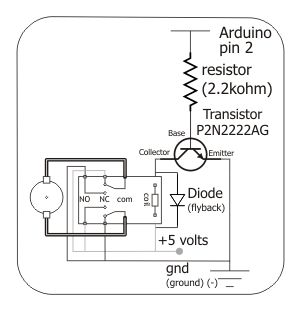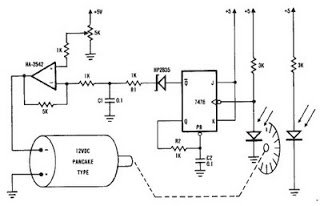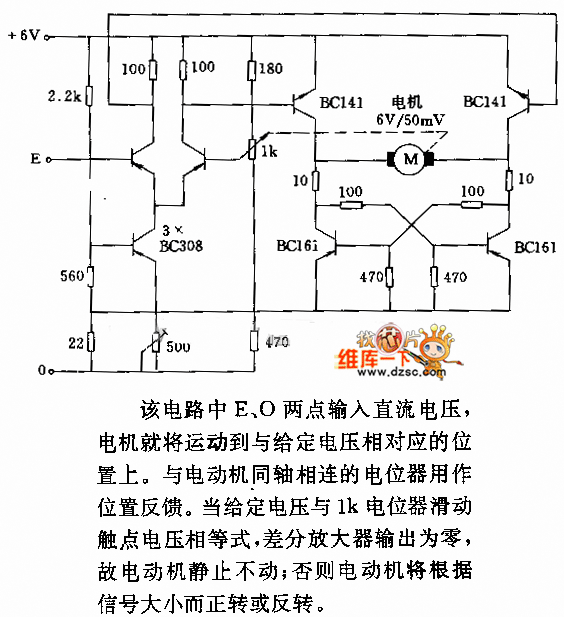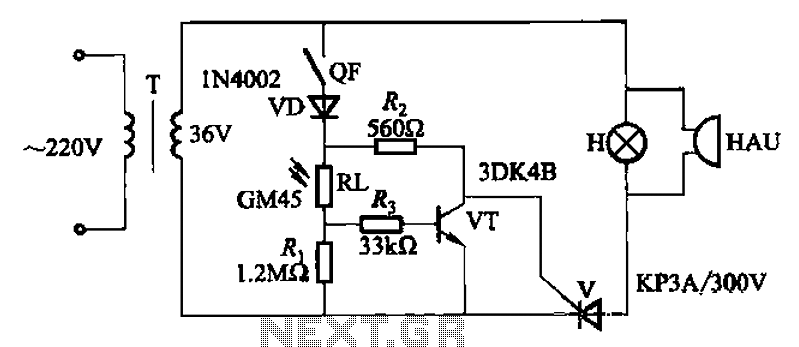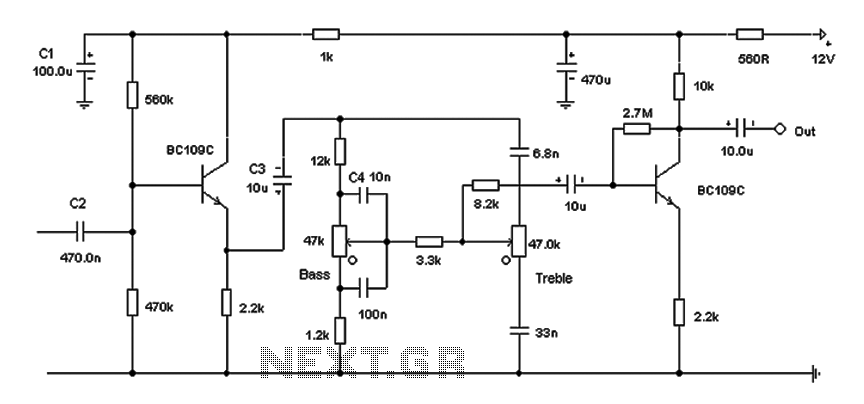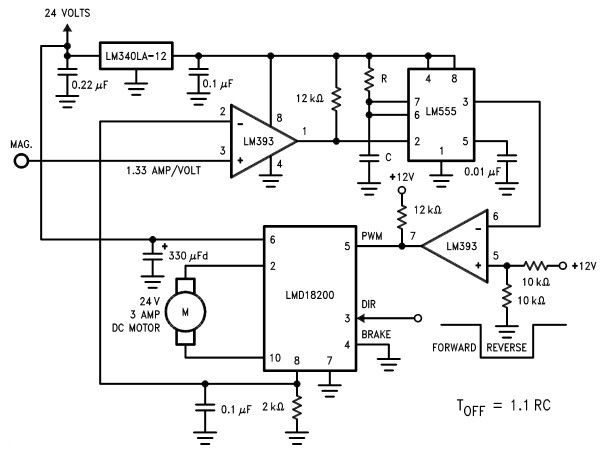
High quality tone control
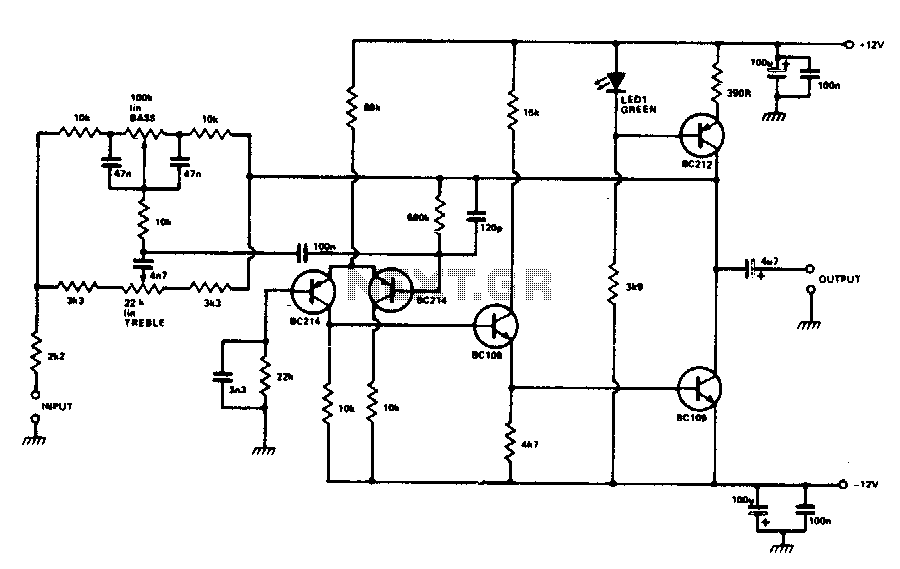
The circuit utilizes an inverting operational amplifier configuration with discrete transistors to address issues such as inadequate slew rate, significant distortion, and elevated noise levels. The output stage is powered by a constant current source, which is biased using a green LED to ensure temperature compensation. When the controls are set to flat, the unit maintains a unity gain, allowing the stage to be easily switched on or off. This design accommodates input voltages ranging from 100 mV to 1 V, offering a substantial overload margin while minimizing distortion for precise transient reproduction. Additionally, standard precautions to prevent hum should be observed.
The circuit employs an inverting operational amplifier (op-amp) configuration, which is a common approach in analog signal processing. The use of discrete transistors instead of integrated circuit op-amps allows for tailored performance characteristics, particularly in terms of slew rate and distortion. The discrete components can be selected based on their individual specifications, enabling optimization for specific applications.
The constant current source in the output stage is a critical element that maintains a stable operating point, which is essential for linear performance. The inclusion of a green LED for biasing serves a dual purpose: it not only provides the necessary bias voltage but also acts as a temperature compensator. This feature helps to stabilize the circuit’s performance across varying temperature conditions, which is particularly important in environments where temperature fluctuations may occur.
The circuit is designed for a unity gain configuration when the controls are flat, making it versatile for integration into various systems. This enables the circuit to function as a buffer, allowing signal switching without affecting the amplitude of the input signal. The capability to handle input voltages from 100 mV to 1 V ensures compatibility with a wide range of signal sources, making it suitable for different applications.
Furthermore, the design emphasizes low distortion and a good overload margin, which are essential for accurate transient signal reproduction. This is particularly important in audio applications, where transient response can significantly affect sound quality. The mention of implementing standard screening precautions against hum highlights the importance of maintaining signal integrity, especially in sensitive electronic environments. Proper grounding, shielding, and layout practices should be followed to minimize interference and ensure optimal circuit performance.The circuit is based on an inverting op amp using discrete transistors to overcome poor slew rate, fairly high distortion, and high noise problems. The output stage is driven by a constant current source, biased by a green LED to provide temperature compensation.
With the controls flat, the unit provides unity gain so the stage can be switched in or out. The design is suitable for inputs between 100 mV and 1V and provides a good overload margin at low distortion for the accurate reproduction of transients The usual screening precautions against hum should be carried out. 🔗 External reference
The circuit employs an inverting operational amplifier (op-amp) configuration, which is a common approach in analog signal processing. The use of discrete transistors instead of integrated circuit op-amps allows for tailored performance characteristics, particularly in terms of slew rate and distortion. The discrete components can be selected based on their individual specifications, enabling optimization for specific applications.
The constant current source in the output stage is a critical element that maintains a stable operating point, which is essential for linear performance. The inclusion of a green LED for biasing serves a dual purpose: it not only provides the necessary bias voltage but also acts as a temperature compensator. This feature helps to stabilize the circuit’s performance across varying temperature conditions, which is particularly important in environments where temperature fluctuations may occur.
The circuit is designed for a unity gain configuration when the controls are flat, making it versatile for integration into various systems. This enables the circuit to function as a buffer, allowing signal switching without affecting the amplitude of the input signal. The capability to handle input voltages from 100 mV to 1 V ensures compatibility with a wide range of signal sources, making it suitable for different applications.
Furthermore, the design emphasizes low distortion and a good overload margin, which are essential for accurate transient signal reproduction. This is particularly important in audio applications, where transient response can significantly affect sound quality. The mention of implementing standard screening precautions against hum highlights the importance of maintaining signal integrity, especially in sensitive electronic environments. Proper grounding, shielding, and layout practices should be followed to minimize interference and ensure optimal circuit performance.The circuit is based on an inverting op amp using discrete transistors to overcome poor slew rate, fairly high distortion, and high noise problems. The output stage is driven by a constant current source, biased by a green LED to provide temperature compensation.
With the controls flat, the unit provides unity gain so the stage can be switched in or out. The design is suitable for inputs between 100 mV and 1V and provides a good overload margin at low distortion for the accurate reproduction of transients The usual screening precautions against hum should be carried out. 🔗 External reference
Warning: include(partials/cookie-banner.php): Failed to open stream: Permission denied in /var/www/html/nextgr/view-circuit.php on line 713
Warning: include(): Failed opening 'partials/cookie-banner.php' for inclusion (include_path='.:/usr/share/php') in /var/www/html/nextgr/view-circuit.php on line 713
